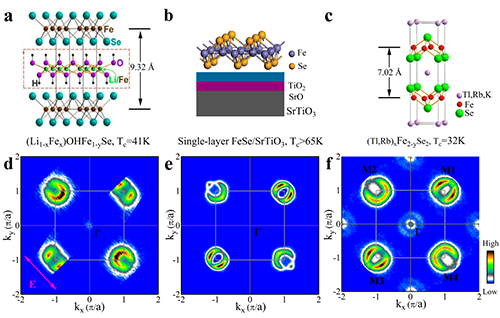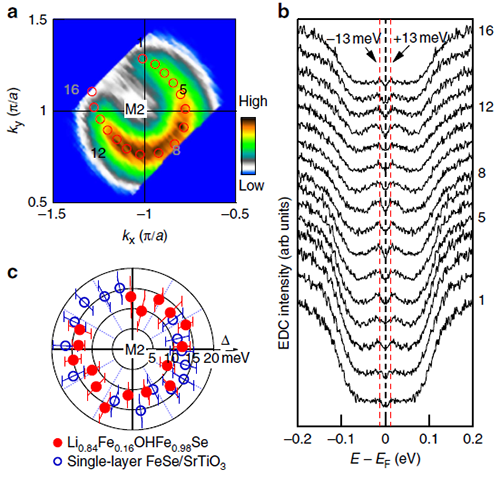Common Electronic Origin of Superconductivity Discovered between (Li,Fe)OHFeSe Bulk Superconductor and Single-Layer FeSe/SrTiO3 Films
Date:22-03-2016 Print
The superconductivity mechanism of the iron-based superconductors remains a prominent issue in condensed matter physics. Most of the iron-based superconductors consist of hole-like Fermi surface sheets around the Brillouin zone center and electron-like Fermi surface sheets around the Brillouin zone corners. It is proposed in a popular Fermi surface nesting picture that the scattering of electrons between the hole-like Fermi surface sheets and the electron-like ones drives the superconductivity of the iron-based superconductors.
The Fermi surface nesting picture is challenged by later experiments on AxFe2-ySe2 superconductor (superconducting transition temperature Tc~32 K) and single-layer FeSe/SrTiO3 films (Tc~65K) because both of them contain only electron-like Fermi surface sheets and no hole-like Fermi surface sheets exist near the Brillouin zone center. However, the FeSe/SrTiO3 films involve interface effect on superconductivity while AxFe2-ySe2 superconductor is known to have phase separation issue and also involves possible interface effect. These complications in these two systems make the questioning of the Fermi surface nesting picture inconclusive.
The high-resolution angle-resolved photoemission study on a new (Li,Fe)OHFeSe superconductor (Tc~42K), performed by Prof. ZHOU Xingjiang’s group in the Institute of Physics, Chinese Academy of Sciences, provide new clues on this important issue. They found that (Li,Fe)OHFeSe superconductor shows similar electronic structure and superconducting gap to that of the single-layer superconducting FeSe/SrTiO3 films and AxFe2-ySe2 superconductors, i.e., it contains only electron-like Fermi surface around the Brillouin zone corners, and nearly-isotropic superconducting gap on the Fermi surface. These observations provide important information on understanding the unusually high temperature superconductivity discovered in the single-layer FeSe/SrTiO3 films. Moreover, because (Li,Fe)OHFeSe superconductor is a single-phase bulk material, it makes it possible to have a direct comparison with most of the iron-based bulk superconductors. The lack of hole-like Fermi surface in (Li,Fe)OHFeSe superconductor with a relatively high Tc~42 K completely rules out the Fermi surface nesting picture on the necessity of the hole-like Fermi surface sheets in giving rise to superconductivity in the iron-based superconductors.
This study entitled “Common Electronic Origin of Superconductivity in (Li,Fe)OHFeSe Bulk Superconductor and Single-Layer FeSe/SrTiO3Films” was published on Nature Communications.
The study was supported by the National Natural Science Foundation, the Ministry of Science and Technology of China, and the Chinese Academy of Sciences.
 |
| Fig.1 Crystal structure and Fermi surface of (Li,Fe)OHFeSe superconductor, single-layer FeSe/SrTiO3films and AxFe2-ySe2superconductor. (Image by Institute of Physics) |
 |
| Fig.2 Similar band structures of (Li,Fe)OHFeSe superconductor, single-layer FeSe/SrTiO3films and AxFe2-ySe2superconductor, and their comparison with band structure calculations. (Image by Institute of Physics) |
 |
| Fig.3 Momentum-dependence of the superconducting gap around the Fermi surface in (Li,Fe)OHFeSe superconductor. (Image by Institute of Physics) |
Contact:
Institute of Physics
ZHOU Xingjiang
Email:XJZhou@iphy.ac.cn
Key word:
Superconductivity; Fermi surface; photoemission;
Abstract:
The common electronic structure discovered between the new (Li,Fe)OHFeSe superconductor and single-layer FeSe/SrTiO3 films provides significant information on understanding the unusually high temperature superconductivity in the single-layer FeSe/SrTiO3 films, and the superconductivity mechanism of the iron-based superconductors.

